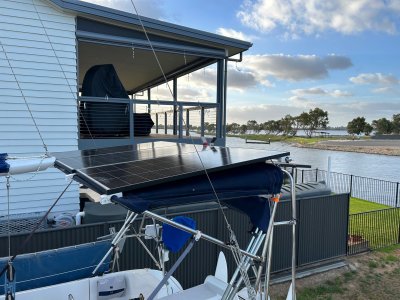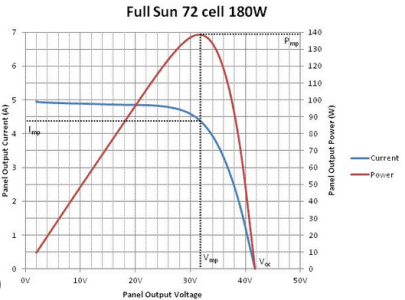chris-s
Well-Known Member
Our new-to-us boat has a single 80watt rigid panel mounted on the doghouse. For the most part I'm sure this will be sufficient but want to be able to connect in a second 'wandering' panel temporarily for a boost as needed. The plan would be to connect it in parallel with the existing panel. I cannot swap out the existing panel for a larger one in its position and I do not want to do something like replace it with two permanently connected 100watt panels hanging off the side. I swapped out the original charge controller for a Renogy DCC30S which has a max solar voltage of 25v/400W, plenty for my expected use. For those not familiar with this controller it separates the engine and house batteries but includes a dc-dc charger to charge the two sets from a combination of alternator and solar power sources. House batteries currently consist of a pair of old 100ah AGM that are likely to get replaced this season, most likely like-for-like although the Renogy charger will support lithium house and flooded engine batteries. We haven't really worked out the electrical consumption on the new boat yet, but I think I feel the current battery setup is sufficient...for now.
So everything I read about mixing mismatched panels suggests the world is going to end, ok, probably a slight exaggeration. But just how closely do they need to match to avoid significant losses?
The existing panel is 80W, open circuit voltage (Voc) 22.5v and operating voltage (Vmp) of 18v.
As some examples, I was looking at some of the Renogy flexible and 'folding suitcase' options like these...
1) 100W Voc 22.5v Vmp 18.9v
2) 100W Voc 21.6v. Vmp 18.0v
3) 120W Voc 23.8v Vmp 19.8v
4) 175W Voc 23.9v Vmp 19.5v
As it happens, I do have the solar setup from the previous boat, a rigid Renogy 80w panel that pretty much matches the specs of the existing panel on the new boat and a Victron mppt charge controller. But I would prefer to use a lighter flexible less bulky panel and avoid having to wire in a separate charge controller if the world isn't going to implode.
Thanks
Chris
So everything I read about mixing mismatched panels suggests the world is going to end, ok, probably a slight exaggeration. But just how closely do they need to match to avoid significant losses?
The existing panel is 80W, open circuit voltage (Voc) 22.5v and operating voltage (Vmp) of 18v.
As some examples, I was looking at some of the Renogy flexible and 'folding suitcase' options like these...
1) 100W Voc 22.5v Vmp 18.9v
2) 100W Voc 21.6v. Vmp 18.0v
3) 120W Voc 23.8v Vmp 19.8v
4) 175W Voc 23.9v Vmp 19.5v
As it happens, I do have the solar setup from the previous boat, a rigid Renogy 80w panel that pretty much matches the specs of the existing panel on the new boat and a Victron mppt charge controller. But I would prefer to use a lighter flexible less bulky panel and avoid having to wire in a separate charge controller if the world isn't going to implode.
Thanks
Chris


